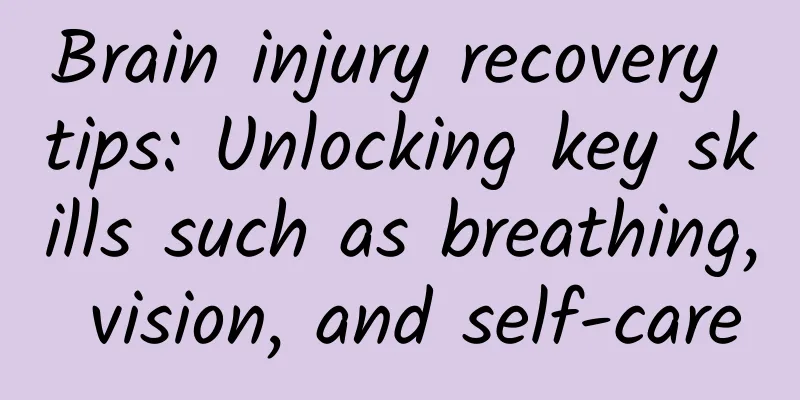Brain injury recovery tips: Unlocking key skills such as breathing, vision, and self-care

|
Author: Zhang Hao, Chief Physician, China Rehabilitation Research Center (Beijing Boai Hospital) Reviewer: Wan Weiqing, Chief Physician, Beijing Tiantan Hospital, Capital Medical University As a common neurological injury, rehabilitation treatment for brain trauma is crucial for patients to restore their quality of life and reintegrate into society. The following will discuss in depth the rehabilitation treatment of patients with brain trauma, especially respiratory and expectoration function training, visual impairment rehabilitation, improvement of self-care ability, prevention of urinary tract infection, and vocational rehabilitation, aiming to provide comprehensive rehabilitation guidance for patients and their families. During the rehabilitation process of patients with brain trauma, training of respiratory and expectoration functions is an important link that cannot be ignored. This training can be started during the patient's critical illness, and even when the patient is unconscious and assisted by a ventilator, attention should be paid to his respiratory function. Because at this time, the patient's diaphragm and intercostal muscles may have problems, early breathing training can help the patient get off the machine as soon as possible, control lung infections, and reduce the occurrence of complications. Breathing training is not only for patients with chronic respiratory diseases, but also for patients with brain injuries, because they often have problems with breathing, lung function, and thorax. There are various forms of breathing training, such as deep inhalation and deep exhalation exercises, blowing candles, blowing paper strips, and even singing, which can effectively exercise the patient's respiratory muscles. Each training session does not need to be too long, about 15 minutes is enough, but the training effect is significant, which can improve the patient's respiratory function and has positive significance for prevention and auxiliary treatment. Figure 1 Original copyright image, no permission to reprint For patients with brain trauma who are undergoing respiratory and expectoration function training at home, family members can assist the patients in performing some simple exercises. For example, they can help the patients squeeze the chest, pat their backs, and change their positions to promote the discharge of sputum. At the same time, patients are encouraged to practice deep coughing, try to cough up the sputum, and avoid swallowing. In addition, the patient's respiratory function can also be enhanced through deep breathing exercises, blowing balloons, or whistling. These home trainings are simple and practical, and can assist patients in continuing rehabilitation training in their daily lives. Visual impairment is one of the common complications of patients with brain trauma, among which hemianopsia is a typical one. Hemianopsia means that the patient can only see objects on one side. This is due to problems with the visual pathway caused by nerve damage. For such patients, the key to rehabilitation lies in compensatory training, such as turning the head to look at objects, and constantly reminding patients to pay attention to blind spots in daily life to avoid collisions or falls. Unlike hemianopsia, unilateral spatial neglect is another visual disorder that is more related to parietal lobe damage, manifested as the patient's neglect of the space on the affected side. The treatments for these two visual disorders are different, but both require specific visual stimulation and training to improve the patient's visual function. Improving the ability to take care of oneself is one of the main goals of rehabilitation for patients with brain trauma. Improving the ability to take care of oneself should be a priority from the time the patient first becomes ill to the entire rehabilitation process, whether in the hospital or at home. Through rehabilitation training, patients can gradually learn to dress themselves, eat, wash, and perform other daily activities. For patients who have difficulty coordinating their hands, they can use the healthy hand to complete the movements, or use assistive devices such as clips to complete some fine movements. In addition, training patients in simple mobility skills such as walking from the bedroom to the bathroom, and using wheelchairs for transfers, are important components of improving the ability to take care of oneself. These trainings can not only help patients achieve self-care, but also expand their living space and improve their quality of life. Urinary tract infection is a common complication in patients with brain trauma, especially in patients with severe brain injury. This is mainly because after the central nervous system is damaged, the patient's urination function is affected, and they are prone to problems such as urinary incontinence or urinary retention. In order to prevent urinary tract infection, patients need to urinate regularly, keep a urination log, and observe urination patterns and urine volume. For patients with catheters, the catheter should be removed as soon as possible, and auxiliary devices such as urine collectors or diapers should be used. At the same time, maintaining adequate water intake and urine volume, and avoiding excessive urine retention, are also important measures to prevent urinary tract infections. For patients who have already developed infections, bacterial culture and antibiotic treatment are required in a timely manner. Figure 2 Original copyright image, no permission to reprint Vocational rehabilitation is an important way for patients with brain trauma to return to society. Through vocational training, patients can choose a career direction that suits them according to their physical condition and interests. For patients with functional impairments caused by brain trauma, such as paralysis, cognitive impairment or language impairment, personalized vocational rehabilitation training is required according to their specific circumstances. This includes training patients on how to use assistive devices to complete their work, changing their career direction to adapt to new work capabilities, etc. At the same time, society should give more support and attention to patients with brain trauma, provide fair employment opportunities and necessary career counseling, and help them return to society smoothly. |
<<: After a brain injury, how can we gradually regain lost motor skills?
>>: Choking, paralysis...How do patients with brain trauma deal with these problems?
Recommend
How can women replenish qi and nourish blood?
Qi and blood are very important for a person, esp...
Pregnant women have stomach pain due to excessive walking
Pregnant women are very fragile during pregnancy,...
I had a laparoscopic ectopic pregnancy.
Hysteroscopy is a treatment method specifically u...
Will I gain weight during my period?
The thing women worry about most is gaining weigh...
Why do my fingers swell after childbirth?
Childbirth is a very important event in a woman&#...
The harm of drinking cold water during pregnancy
We all know that there are many taboos for women ...
It is good to eat more eggplants in summer, without stir-frying or frying. So how to eat it?
The weather is hot, and many people like to cook ...
How long is the right time to have an abortion during pregnancy and what should you pay attention to when having an abortion
Pregnancy is inevitably an accident, so do you kn...
How to treat amenorrhea in girls?
If you have amenorrhea at an advanced age, you wo...
What to do if your thigh hurts after a normal birth
When women give birth, except for special reasons...
Who can't eat green kumquat? How to eat green kumquat
In addition to eating it fresh, the most common w...
What causes breast pain?
In fact, many female friends have experienced the...
Does drinking more water help women with hematuria?
Because women have menstrual periods, sometimes w...
Will a married woman's three abortions affect her fertility?
The impact of abortion on married women is enormo...
What is the best contraceptive method?
Many modern families do not want to have a second...









